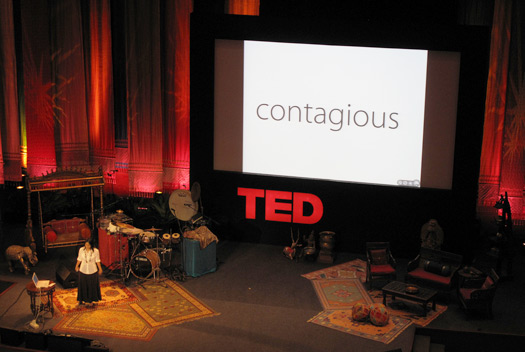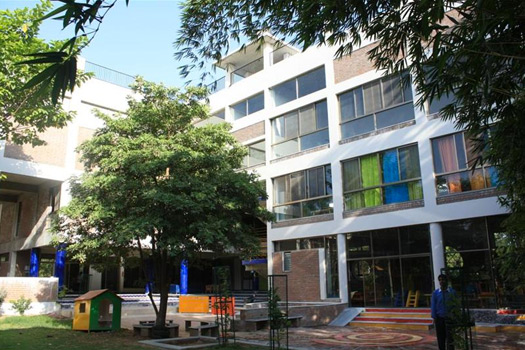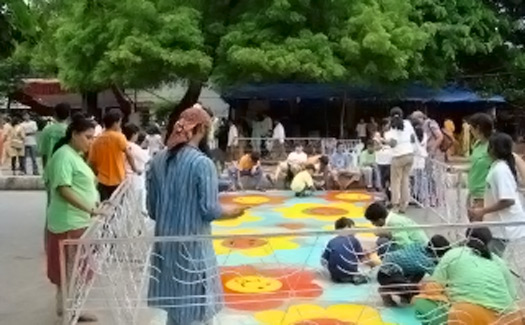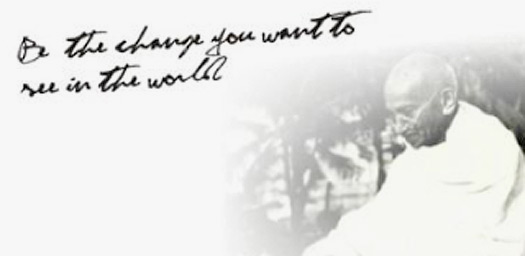
Kiran Bir Sethi, at the 2009 TED India Conference, photo by Vasudev Bhandarkar
Kiran Bir Sethi is a designer who became a teacher, a principal who grew into an education reformer, an advocate who morphed into a social entrepreneur. A trained graphic designer, she comfortably uses the language of design — iteration, prototype, design specs — to develop not only curriculum innovation, but also community-based social programs. Sethi was a star at the first Ted India last year, where she movingly told stories of how she champions children. But her “Design for Change School Contest,” a recent initiative only mentioned near the end of this talk, swept India like wildfire in 2009, and will expand globally this coming school year.
Riverside School, Ahmedabad India, 2009
After graduating from the National Institute of Design in 1989 with a degree in graphic design, Sethi moved into education, founding the Riverside School in Ahmedabad, India, in 2001 with only 27 students in elementary grades. (Not one to be pigeonholed, she also did stints as a reporter for the Times of India, television actress, and lead singer in a popular rock band in Gujarat.) Riverside, a mainstream private school, has grown one grade a year: next year it will extend up to 10th grade with 330 students and 64 teachers. This past year, Sethi opened the newest building to accommodate coming expansion and growth into a full K-12 school. Cheerful, well-constructed, an oasis almost, the campus bears little resemblance to other compounds or institutional buildings in Ahmedabad.
Riverside School is viewed as a laboratory to prototype design processes that enable “exceptional” teaching and “transformative” student participation, in Sethi's exuberant vocabulary. All curriculum development is custom, developed year-by-year, tested with student feedback and then modified: both processes and outcomes are captured on paper, documented for future use and refined. In 2004, Riverside began selling its curriculum and teacher-training methods to other Indian private schools, creating a model for financial sustainability. In 2005, Sethi began collaborating with Indian regional governments, donating the curriculum models to public schools in numerous regions. More recently, she has been working with the Indian Army to adapt the Riverside model to army schools across India, established the first "Beacon School" in Bhutan, and introduced a Riverside curriculum pilot for teaching English as early grade one (versus the standard introduction in grade five) in two municipal schools in Ahmedabad.
A Protagonist in every Child (aProCh), Children making India's first child-friendly zebra crossing, Ahmedabad India, 2008
Once Sethi started down this path of child-focused innovation, the question of children safety and integration in large urban environments became paramount. She twisted the question around: how could children be active citizens in Ahmedabad a city of 5.2 million inhabitants? A Protagonist in Every Child (aProCh) is a long-term campaign to see how children can engage with a large city — not only making the city safer for children, but also teaching them to be active participants and citizens. The program’s reach is vast: a major road through Ahmedabad is closed once a month for a day of citywide child activities; businesses, news agencies and NGOs regularly open their workplaces to children so they can experience the city’s social infrastructure; and children are now planning the next two parks to be built by the city government. Since its founding in 2007, the aProCh initiative has sponsored more than 35 public events involving thousands of local citizens, and the program is now moving to other cities in the region. As a result of this work, Sethi was named an Ashoka Fellow in 2008.
M. K. Gandhi, motto for Design for Change Contest, 2009
In early 2009, Sethi launched her biggest initiative to date, a national campaign that encourages schoolchildren across India to participate in a one-week project to change some aspect of life in their own communities. With only a few months’ lead time, she bravely vowed to involve 20,000 schools and 100,000 students. In fact, 32,274 schools across India participated in the "Design for Giving School Contest”, and hundreds of thousands of school kids were involved. Participants entered as student teams represented through a classroom, grade, or school. Having been invited to "redesign" their communities, winners were chosen based on their projects’ impact according to the number of people affected, quickest impact, maximum potential for long-lasting change, easiest to replicate, and most environmentally friendly. A special Gandhi Prize was also awarded — all projects take place the week of October 2, the revered leader’s birthday.
Sethi roped in lead time, she bravely vowed to involve 20,000 schools and 100,000 students. In fact, Rahul Bose, a famous Indian actor and activist, as competition host and public figure. The jury was a who's who of Indian designers, along with representatives from U.S. design firms and schools such as Continuum, IDEO and the Hasso Plattner Institute of Design at Stanford. She's also working with Stanford's d-school on jury process and curriculum design, and with Harvard School of Education on measuring impact in the classroom. Always wanting to apply design processes, Sethi insists, even for a contest, on circling back to assess and measure success and failure. Her own survey of student participants found: 78% from cities; 56% were ages 12-13; a 53%/47% female/male split; 29% and 21% of projects, respectively, addressed environmental or educational issues; and 73% said they would participate in community service projects in the future.
The thousands of projects submitted to the "Design for Giving School Contest" ranged across nine languages and diverse imperatives. Among them: Save Our Mangroves, Help Reach the Unreachables, Avoid Transgender Discrimination, Care for and Protect the Homeless, and Stop Child Marriages. Also proposed were Collect Plastic Bags Week, , Playground for Children, Dignified Attire, and a Stop Spitting Campaign. My favorite proposal came from a village where the crematorium was located next to the schoolyard. Children who had clear sightings of burials during recess organized to petition the town council to erect a wall blocking their view. The wall doubled as a space for posting public announcements. Per the contest’s stipulations, this project too was accomplished within a week.
The “Design for Giving” awards ceremony can be viewed online, as can numerous project videos. Notable examples also include Recycling Newspapers to Make 1,000 books for Other Schoolchildren, Teaching Parents to Read and Write, and Private School Repaints Public School.
Sethi is taking this project global in 2010–11. Renamed the "Design for Change School Contest," the model has already been adopted by seven countries that are participating through a global site: Canada, Finland, India, Mexico, Pakistan, Thailand, and the United Kingdom. Soon to be added are Australia, Bhutan, Brazil, Indonesia, Ireland, Japan, New Zealand, Philippines, Romania, Singapore, South Africa, South Korea, Sri Lanka, and the United States. (And a new twitter feed just started this week.) Design Observer Group is a knowledge partner in the “Design for Change School Contest,” and I will be a juror during this year's competition. We will provide updates on this Project Report every month.
"'Design for Change' is not a project or an initiative,” Sethi says. “It is a movement. We are going to impact the lives of a billion people. It may take a year or two, but I'd prefer to do it this year. There are so many children to help — and who can so help us too."
